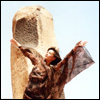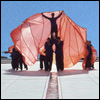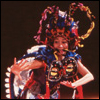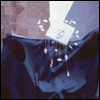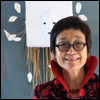Good News
Sydney Herald (Australia) November 20, 1979
Three-day dance Is moving
By Jill Sykes
Between Silence and Light. a three-day dance event devised by Yen Lu Wong for the One Extra Dance Group, performed outdoors in Sydney on Friday, Saturday and Sunday.
This has been an extraordinary dance event, both a revelation and a celebration involving hundreds of people in public places that will never seem the same to them again.
It began by the light of the setting sun on Observatory Hill, with the white-clad dancers emerging over the curving green slope against a backdrop of urban living and slowly moving cargo ships.
In turn, they represented the Keepers of the Earth, the Destroyers of the Earth, the Settlers and Those who Seek to Enter. They expressed their joy and respect for the earth and demonstrated how it could be destroyed by thoughtlessness.
Yen Lu Wong, a Los Angeles-based choreographer who presented this event with the help of the Australia Council and the NSW Government, made evocative use of the surroundings.
The trees, the angle of the sunset and, above all, the slope ot the hill, shaped her creativity. The movements she devised for her 15 dancers were suitably acrobatic rather than balletic - except for one solo, which was symbolically so.
The fact that they were performing on an uneven wet grass surface didn't stop her making demands on their technical ability. The extremes of speed and slow motion were achieved only through constant practice and absolute concentration and control in the tricky circumstances of execution.
A group of musicians supplied chiefly percussive sounds - drums, gongs, chants and calls, with the occasional peripatetic wind player - in music composed by Colin Offord which was ideal for both the outdoor venue and the wide-ranging thematic content.
The combined result was overwhelmingly moving. As a dramatic visual experience alone, it would have been memorable. But the ideas and commitment which activated it gave the event an artistic completeness and meaning which could not help but arouse an emotional response.
The second section, performed in darkness on the northern broadwalk of the Opera House, was a dance of lights in the ritual tradition of many countries. It was devised as a symbolic joining of water and earth, and a celebration of the spirit of hope.
Again, the surroundings were used superbly. Paper “birds” flew in the olive trees, candles glowed, and the dancers, looking like candles themselves with tall, peaked, torchlit head-dresses, made their way down the steep steps outside the Opera Theatre and the Concert Hall.
The dance itself was less creative in that it was designed primarily to produce a pattern of lights held in the dancers' hands - lights which were offered to the Harbour before the dancers made a dramatic exit into the vast cavern of the Opera House dock, whose door opened like a giant dragon's mouth just as they reached it.
Light, as this was entitled did, not reach me emotionally, but its visual impact was beautiful and its delicacy against the monolith of the Opera House was something extraordinary.
Renewal, the final section on Sunday at noon, began as a procession winding through the Rocks and finished in a celebration shared by dancers and audience alike in Argyle Place. It was a httingly joyous finale.


